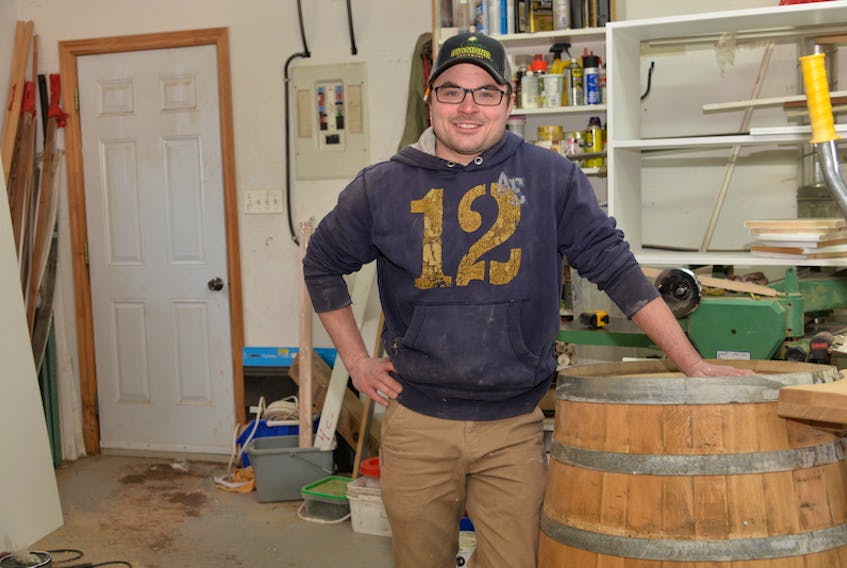LOWER FREETOWN, P.E.I. — When Jordan Stetson launched his business a few years ago building large, oak barrels, otherwise known as foeders, for the craft beer industry, he wasn't exactly sure how the business would unfold.
But even he was surprised when he was contacted by a company in Sweden, and another one in Uruguay, recently inquiring about the foeders (pronounced food-ers) he manufactures in the small community of Lower Freetown, P.E.I.
"That's probably been the farthest away that I've had requests for quotes on. I had priced out the one in Uruguay, but the freight there would be a little prohibitive," said Stetson, 30, who started New World Foeders in late 2017. He referred the Swedish request to a supplier in Scotland.
"It's interesting the reach (the business) has had on social media," he said.

Growing business
Stetson also divides his time working as a carpenter, so creating things out of wood comes naturally. Even so, building foeders has been a learning experience.
"It's been an experimentation and learning process the whole way through. And it's grown more than I even expected it to. Everything for the most part is a self-taught process," he explained.
In the fall of 2018, he was one of 10 recipients of the province's $25,000 Ignition Fund grant to help grow the business. Working as a carpenter also helped out during COVID-19, especially when some potential foeder customers got cold feet with purchases given the economic conditions.
Stetson got the idea to build foeders years earlier while working as a project manager for Diversified Metal Engineering (DME) - a Charlottetown-based company that manufactures equipment for the brewing industry. Part of his job involved travelling around North America helping install the equipment at breweries. The first time he saw a foeder was at one of those breweries. It piqued his interest, so he started doing some research into the product and realized that there was a market for manufacturing them.
"I liked the idea of being able to build something myself again. I wasn't much of a welder, so I like working with wood as opposed to metal," he said with a laugh.
Stetson also likes the history of foeders and wood barrels.
"People have been building barrels by hand since Roman times. And to look at the technology that I use to build it versus the way people have done it is mind-blowing," he said.

Early on, Stetson supplied craft breweries and wineries with smaller foeders in the 400 to 750-litre range. But now, the demand is for larger ones more than 1,000 litres. By comparison, a 1,200-litre foeder could produce a batch of 3,380 - 355 ml cans of beer.
So far, he's built and sold about 12 foeders for customers in different parts of Canada. Some of his local customers are Upstreet Craft Brewing, Lone Oak Brewing Co. and Deep Roots Distillery on P.E.I. as well as the Gahan House in Halifax, and in New Brunswick - O'Creek Brewing and Grimross Brewing Co.
It takes Stetson a couple of weeks to build a foeder. The larger 1,200-litre ones are about three-metres tall and two-metres wide. He is currently working on two, 1,200-litre foeders for a client in Lunenburg, N.S., and is quoting an order for four, 1,000-1,200-litre foeders and around four refurbished barrels for customers in British Columbia.
Besides building foeders, Stetson also refurbishes smaller barrels for breweries, wineries and distilleries.
How do foeders work?
Lone Oak Brewing Company in Borden-Carleton bought its 1,300-litre White American Oak foeder from Stetson in 2019.
Spencer Gallant, Lone Oak's co-owner and head brewer, said that a full batch that size would produce about 2,600 - 500 ml bottles.
Gallant explained that he has had batches of beer aging in the foeder from six weeks to eight months.
"It's essentially a conditioning vessel where the liquid, or beer, will reside for an extended period of time," he said. "The foeder or barrel is just another ingredient. I kind of say these beers have the fifth main ingredient, which is the oak character."

Gallant doesn't add yeast to each batch. Instead, the value of a foeder is that it can have a house culture of yeast, bacteria and microbes that live and evolve in the pores of the wood, and carry over from batch to batch and to create a unique flavour profile and ferment the beer.
"It'll change from batch to batch depending on the liquid that I put in. So, I can feed the yeast in a way so it gives the flavour I'm looking for in a certain style," he said.
Gallant can also add other ingredients, such as fruit, to the foeder. For example, their Rouge Farmhouse Ale was brewed and aged for three months with 300 pounds of grapes in addition to the other ingredients, which also includes the flavour of the oak.
"Oak-aged beers are still pretty new to the consumer here. So it's really interesting to give a foeder-aged beer to a customer that has never had one before. And they think it's something they may not like, but then it turns out they're very easy beers to drink. They're very soft and they can be fruity and floral. It's kind of endless the opportunities you can do with different fruiting, different hopping rates, different grains that we use."
Gallant said he hopes to get a couple more foeders, smaller ones, so he can do more blending of different beer.
"The real art is in blending, and being consistent," he said. "And I appreciate the historic story that goes along with (foeders). I try to stay pretty traditional in our brewing methods."
Stetson is also aware of the role his craft plays in the industry, especially the idea that something he builds from scratch in the workshop contributes to someone sitting in a pub enjoying a pint.
"That is neat," he said. "And contributing to the flavour or the profile of whatever it is they're enjoying is kind of unique and is nice, too."
Terrence McEachern is a local business reporter for the SaltWire Network.









